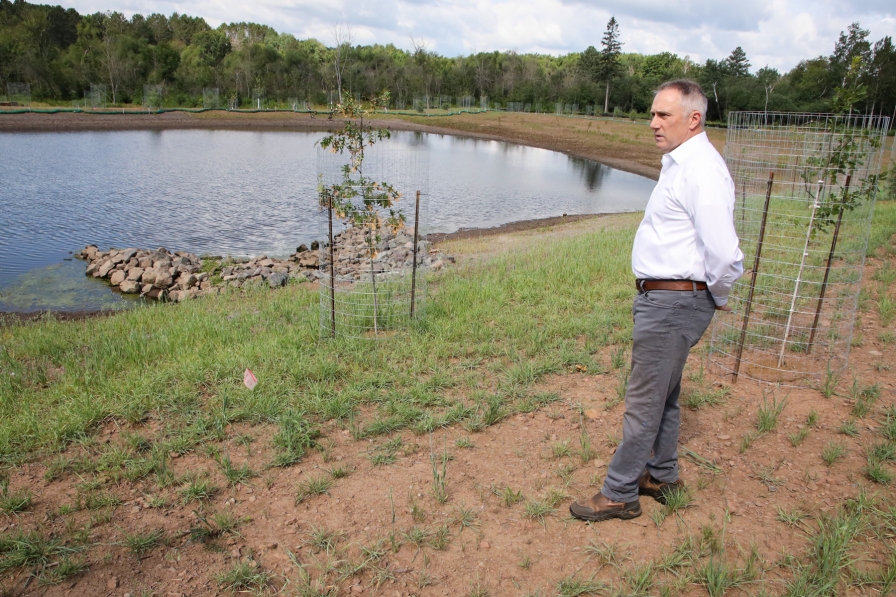
10 acres in Duluth’s Hartley Park now protect a coldwater trout stream and Lake Superior
In the middle of Duluth sits Hartley Park, 640 acres of wooded land that residents cherish and use to hike, ski, and bike. It's the home of a popular nature preschool and community education. Water in the park flows to Tischer Creek, a coldwater trout stream that empties into Lake Superior on the grounds of Glensheen mansion, Duluth’s most famous historic home.
When St. Louis County started to plan road construction near the park in 2021, the MPCA’s Jesse Martus saw an opportunity not just to improve stormwater runoff in the park but also to provide better protections for Lake Superior and to get more people in the community thinking about their impact on local ecosystems.
“We need to rethink stormwater,” he said. “You can live in an urban area, and if you take care of it, it can be amazing. Too often, people see urban tributaries just as stormwater conveyance systems. But we need to start seeing these places as real streams, with life and value, not just pipes for water to run through.”
Martus works in the MPCA’s Watershed Division as a coordinator for Lake Superior Lakewide Action and Management Plan (LAMP), which works with dozens of agencies to protect the lake’s ecosystem. Specifically, Martus identifies federal funding opportunities, such as the Great Lakes Restoration Initiative, and in 2020, he began reaching out to cities and counties to explain those opportunities. Martus said his work sometimes boils down to a “sales pitch” as he encourages people to see larger opportunities, especially where large stormwater outfalls intersected with public land and where green infrastructure could be built.
“Before I started working here, there was less awareness of the grant opportunities, and so our partners were missing out on a lot,” he said. “I put that together in a graphic, a table about how little participation we had, and then how high the success rate was if you did participate. Now we have very vigorous participation.”
A well-timed opportunity
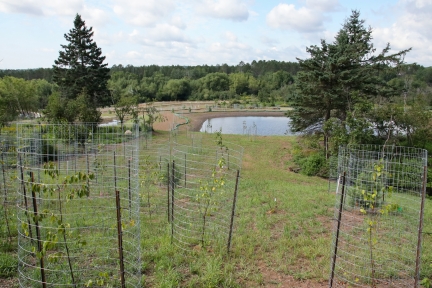
At the project’s start, county officials worked with a local consultant on a design that would treat stormwater flow. This preliminary work helped the county secure $600,000 GLRI grant through the U.S. Army Corps of Engineers, matched 25% by the county for a total of $800,000. One problem with the initial design was that several white pines the city wanted to preserve would have to be cut down. The county went back to the drawing board and, by partnering with Duluth to make use of city land, came up with a rough design of what exists today, white pines included. They pursued a $500,000 competitive Clean Water Fund grant, without which the project would have been capped at $800,000. This new design was ambitious, treating considerably more stormwater, eventually growing to a $2.5 million multi-agency collaboration. The U.S. Army Corps of Engineers was also able to provide greater assistance through the GLRI funding, totaling $1,896,000 of federal assistance.
“Several factors made this a great opportunity,” Martus said. “We had local support, the county resurfacing project, a large area of land, and the opportunity to treat a major stormwater outfall. We just had to pursue it.”
Tischer Creek is impaired by E. coli bacteria and diminished water quality due to a myriad of factors common in urban streams, including runoff from roads, stream temperature fluctuations, erosion, and “flashy flow,” meaning the waterflow goes quickly up and down. The project improves the creek’s water quality by capturing water from a 117-acre drainage area. Instead of flowing directly into the creek, water will be captured and filtered in a pretreatment vault, stormwater pond, and five basins. A biochar amendment is mixed into the sand in one basin to reduce bacteria. Each year, the system will remove an estimated 22,000 pounds of sediment, 202 pounds of nitrogen, and 50 pounds of phosphorus.
“The city of Duluth is going to see the benefit of a modernized stormwater conveyance,” said Ryan Granlund, utility programs coordinator for the city of Duluth.
The city will maintain the system, vacuum the vault, and determine ongoing maintenance needs.
“We’re going to continue to remove heavy sediment and trash from the vault,” Granlund said. “We plan to vacuum it out twice a year, though it’s looking like it might be even more than that. It does really well; it captures a lot.”
A visible legacy
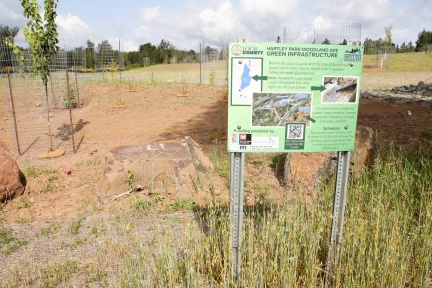
One of the project’s strengths is its visibility. Interpretive signage explains how the system works and who funded it. The project serves as a demonstration site and offers educational opportunities.
“The stormwater project offers an opportunity for us to create new programs or exhibits that help educate members of the community about stewardship in Hartley Park, and how projects like this can have a positive impact on our local ecosystem,” said Matt Willey, stewardship and recreation program manager for Hartley Nature Center.
One priority for LAMP projects is to restore and protect native trout in Lake Superior. Fish face challenges in creeks from dams, culverts, and untreated stormwater. Thermal pollution in the form of warm summer stormwater is a problem, too. New measures in Hartley Park will cool water before it enters the stream and reduce the introduction of sediment, chemicals, salts, and litter. These interventions are designed not only to protect Tischer Creek but also to enhance the broader ecosystem, said Carol Andrews, an environmental engineer with St. Louis County Public Works.
“This project will create a cleaner and hopefully cooler Tischer Creek, including during droughts,” she said. “This will be enjoyed by people fishing, hiking, or just playing in the creek anywhere downstream from the site where the storm sewer previously discharged untreated runoff.”
Andrews highlighted how the project also offered a chance to remove invasive species such as buckthorn, non-native thistles, and tansy, which previously dominated the area.
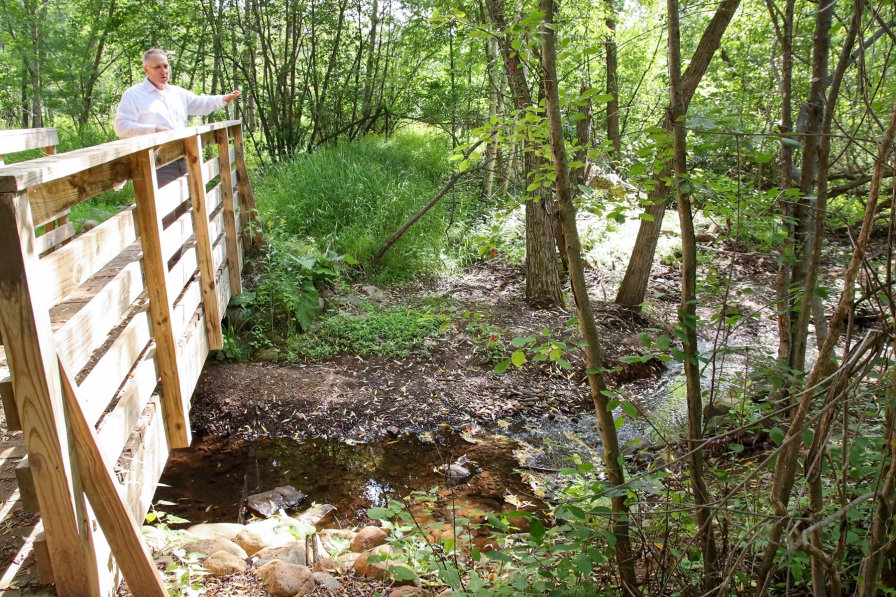
Streams must be high quality for trout to live there, so finding trout can be a surrogate route to identifying healthy streams. And urban trout streams are important for reasons far beyond the actual fish, Martus said.
“These are places where kids swim, catch their first fish, where families walk the trails,” he said. “They’re part of the community. When people see a thriving creek, they start to care more. That’s what stewardship looks like. People will be able to walk through and see real conservation in action. They’ll understand where their tax dollars go, and how clean water gets protected.”
Protect now or pay later
Most Great Lakes restoration money for nutrient reduction currently targets Lake Erie, where algae blooms and pollution are critical concerns. But protecting Lake Superior is cost-effective in the long run.
“Lake Superior is in pretty good shape, and you can spend a small amount of money protecting it, versus what you have to spend to restore a degraded site,” Martus said. “The cleaner we can make Lake Superior, the more we can benefit the health of the lower Great Lakes.”
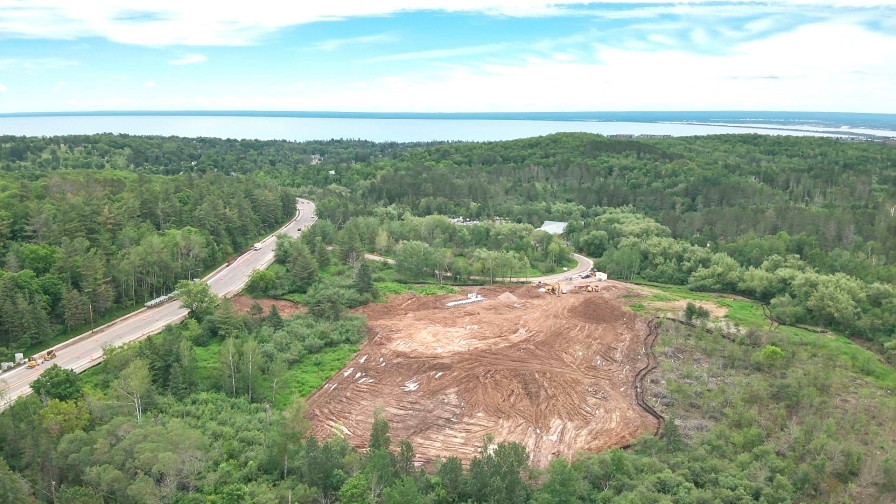
The LAMP program looks beyond what is required by regulation to something aspirational, going above and beyond. The Hartley project creates an accessible green space, and the work doesn’t stop at Tischer Creek. With geographic information system mapping tools, GreenCorps support, and collaboration with city and county engineers, the team has identified other high-priority sites for future stormwater treatment.
“Duluth is pretty unique: It has 16 urban trout streams, and that’s something to be proud of,” said Amy Adrihan, the MPCA’s northeast watersheds supervisor. “It’s not just about water quality. These streams offer real recreational value. A lot of people in the city take advantage of them. That connection to the streams is a big part of the community here.”
Andrews advised other municipalities to think ahead at least three years for projects like this. Look for opportunities to make significant improvements as part of existing road projects, she said. Tying projects in with scheduled work reduces costs considerably.
“Having a good working relationship with people involved with watershed assessment is critical to having an idea of which streams or lakes need improvement,” Andrews said. “Often, these people can help connect you with funding.”
Granlund agreed, saying it was a good experience to work with so many partners, a process made easier because of previous years spent building relationships.
“Through this whole thing, it was really a good, cohesive working relationship that ended with a good outcome,” he said. “It’s really impactful. This is a featured project for Duluth, our region, and probably the state.”
“It’s a lengthy process,” Martus said. “It starts with building enthusiasm and trust, getting agencies, landowners, and local government to commit. This is what it takes: collaboration, persistence, and a bit of salesmanship to move beyond the status quo and do something better."
State grant funding for this project was sponsored by the Minnesota Board of Soil and Water Resources through the Clean Water Land & Legacy Amendment.